| Home | Nature Weekly Index |
19 July 2015 | Fresh Water Snails |
Today, I did not have to go through the weekly routine of scrubbing the algae off the wall of my mini aquarium due to an over population of small water snails. They probably arrived together with the new batch of Java Fern (Microsorum pteropus) or Frogbit (Hydrocharis morsus-ranae) that I added to the aquarium on 20 June.
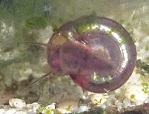
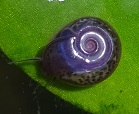
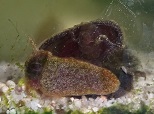
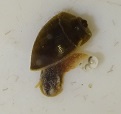 I tried taking their pictures focusing on those crawling on the surface of the tank or on floating leaves but the images were not
too good. Based on my observation, there were at least 2 types of snails in the tank; one was circular and flat while the other one
was conical shape with a much broader body. The circular one was a Ramshorn Snail from the Family Planorbidae. The conical one
should be an Aquatic Pulmonate Snail from the same family as the Ramshorn Snail. In an attempt to control the snail population, I
decided to remove some of them. The ones that were easy to pick up were those crawling on the wall of the tank.
I tried taking their pictures focusing on those crawling on the surface of the tank or on floating leaves but the images were not
too good. Based on my observation, there were at least 2 types of snails in the tank; one was circular and flat while the other one
was conical shape with a much broader body. The circular one was a Ramshorn Snail from the Family Planorbidae. The conical one
should be an Aquatic Pulmonate Snail from the same family as the Ramshorn Snail. In an attempt to control the snail population, I
decided to remove some of them. The ones that were easy to pick up were those crawling on the wall of the tank.

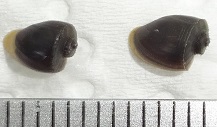
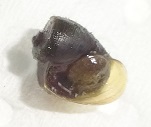 While removing the snails, I took 4 of them, 2 of each type, out of the water to have a closer examination and take some
measurements. The Ramshorn Snail was about 3 millimetres (mm) in diameter while the dimension of the Aquatic Pulmonate Snail was
approximately 4 x 3 mm.
While removing the snails, I took 4 of them, 2 of each type, out of the water to have a closer examination and take some
measurements. The Ramshorn Snail was about 3 millimetres (mm) in diameter while the dimension of the Aquatic Pulmonate Snail was
approximately 4 x 3 mm.
There are many look-alike species of Ramshorn Snail. In the Singapore snail checklist published in 2010, there were 6 snails listed in the Family Planorbidae. Indoplanorbis exustus was much larger in size than the 2 nails in my tank. Two Gyraulus species were list. Physastra sumatrana was excluded as well as its appearance did not resemble the ones that I got. The only one that resembled my Aquatic Pulmonate Snail was Amerianna carinata.
With the elimination of 3 names from the Planorbidae list, I was left with 3 other names for the Ramshorn Snail. One of them, Gyraulus bakeri was assigned a vulnerable status by the IUCN Red List of Threatened Species and with its habitat indicated as mountain streams in eastern Thailand. The other Gyraulus species, Gyraulus convexiusculus, appeared to be a very common fresh water snails. It was indicated by IUCN Red List of Threatened Species as one of the most common snail species throughout its distribution range. The last name, Segmentina species, was also a common Ramshorn Snail.
Based on my deduction and assumed that the Singapore snail checklist captured all the common snails in the Family Planorbidae, the scientific name of the Aquatic Pulmonate Snail should be Amerianna carinata and that of Ramshorn Snail should be either Gyraulus convexiusculus or Segmentina species. In the tank, the Aquatic Pulmonate Snail outnumbered the Ramshorn Snail by at least 10 to 1 ratio. They are really ferocious algae eater, having clear most of the algae on the wall of the tank as well as those on the aquatic plants.